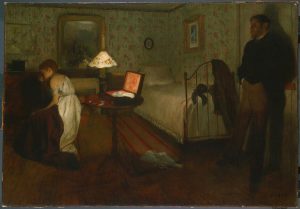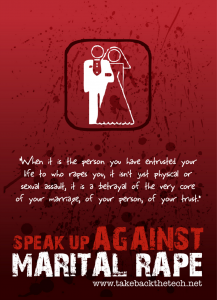Lisa Featherstone reveals the controversies that dogged the campaign to criminalise marital rape in Australia in the 1970s and 1980s in the 16 Days of Activism Against Gender Violence.
From 1976 to 1994, Australian jurisdictions introduced a raft of reforms to sexual assault laws. The new legislations expanded the definitions of rape and other forms of sexual assault, and reconsidered the treatment of victims on the stand. The legislative changes were driven by broader social and sexual shifts of feminism and the sexual revolution, including changing ideas about women’s roles and expanding ideas about sexuality and sexual practice. Most of the reforms were broadly welcomed, and were seen to reflect women’s shifting status within a modern society.
Yet there was one reform that caused substantial controversy: rape in marriage law reform. Though rape in marriage was ultimately criminalised in Australian states and territories, there was significant opposition to the idea that it should be a criminal offence for a husband to sexually assault his wife. Why was this, of all the reforms, so controversial?
The backdrop

The immunity of a husband had a long historical tradition, framed by British common law. The immunity of husbands was established by the eminent judge and jurist Sir Matthew Hale in 1736, in his oft-quoted pronouncement:
A husband cannot be guilty of rape upon his wife for by their mutual matrimonial consent and contract the wife hath given up herself in this kind to her husband which she cannot retract.
What this meant was that marriage was seen as a contract to sex between spouses, no matter how a woman might feel about a particular act of intercourse.
Consent was not part of the equation.
It was – within this framework – legally impossible to rape one’s own wife, in both British and Australian jurisdictions. In cases of more general violence, a woman was technically offered some protection under laws of battery, but a husband could be charged only with physical, and not sexual, assault.
Changing times
By the mid twentieth century, the rising rates of divorce in Britain and Australia led to a conundrum of marital sex: at what point of a separation would a woman no longer be obliged to perform her wifely sexual duties?
A number of common law rulings in the United Kingdom suggested that a husband could expect sex from a wife even after divorce proceedings had begun, but not after a decree nisi had been granted. These rulings chipped away at a husband’s right to sex, but were not a profound challenge to the idea that a husband had an expectation of sex as a core of the marital contract.

By the 1970s, however, this view was increasingly untenable. The feminist movement claimed that women had a right to bodily autonomy under any circumstance, and fought to provide support and socio-legal protection for women in cases of domestic violence and sexual assault.
Feminist influences were felt in the press and in government, and in South Australia the progressive Dunstan Labor government commissioned a Special Report, led by Her Honour Justice Roma Mitchell, to investigate sexual assault, including marital rape. The Mitchell Report strongly condemned the idea that a married woman had committed herself to indefinite vaginal (and anal) sex. But the Mitchell Report still did not suggest that the husband should lose his immunity: rather, it suggested that cases of marital sexual violence should be handled through the Family Court.
To the surprise of many, the South Australia government did not take on the Mitchell Report’s moderate reforms: instead, the Labor party attempted to remove immunity – even while the spouses still lived together. As the Attorney-General noted, ‘a woman should have the protection of the criminal law regardless of whether she was married, unmarried, living with the spouse or not’. The South Australian reforms sparked a series of legislative reforms across Australian states.
Opposition
But criminalising marital rape was far from easy.
Opposition to marital rape law reform came from a wide range of interest groups and individuals, covering a broad cross section of Australian society, including social conservatives, some religious groups, parliamentarians, and conservative women’s groups. But for the majority who opposed criminalisation, at the core of their opposition was the idea that the family home, and in particular the marital bedroom, should not be controlled by the state.
Ultimately, opposition to marital rape law reform took three main forms: the fear of marital breakdown; the ‘vindictive wife’; and the difficulty of proof.
Fears about marital breakdown
The most common – and seemingly persuasive – argument against the criminalisation of marital rape was that it would lead inevitably to family breakdown. Law reform was seen by mainstream conservatives, including members of the Liberal Party, as an ‘attack on the family.’
The prioritising of marriage and family is interesting on two counts. Firstly, it obliterates the notion of consent. While concepts of consent were crucial to the general rape trial, in these debates over marital rape, consent is invisible, unimportant or dismissed.
Secondly, conservatives argued that, while violence against a wife was unseemly, it did not need to lead to the end of a marriage. In debates over the new legislation in New South Wales, one member of parliament claimed:
even after such an appalling event as rape in marriage, some marriages can be saved. However imperfect the institution of marriage may be, it is far too important to society for it to be endangered.
Here, the member does not deny that rape could and did occur, but that marriage – in terms of the individual and the institution – needed to be saved. This served to normalise gendered violence within marriage.
The ‘vindictive wife’
We have seen already how little a wife’s consent was considered in debates over marital sex: a real life woman was almost invisible in these discussions over masculine privilege. Where a woman did become visible, however, was when she became termed a ‘vindictive wife’.
The vindictive wife was a concept developed to show the wife, not as a victim of violence, but as someone who gained power through her control over her body. She might, for instance, deny her husband sex because he had refused her money or quarrelled with her. She might claim to have a headache. Even more alarmingly, the vindictive wife might cry rape when an assault had not occurred. Any women might raise a false accusation against her husband, and it was widely argued in the media and in parliament that men required protection.
The difficulties of proof
The final common excuse for protecting a husband’s immunity was that rape, as a crime, would be impossible to prove.
What happened in the sanctity of the family home – and between a couple who had previously been intimate – would be very hard to criminalise in practice. This argument was mounted by conservatives and progressives alike, with many criminologists and even some radical feminists agreeing that the new laws would offer little protection to vulnerable women.
Dealing with marital rape
 Those who opposed law reform laid out simplistic reasons why legislative change could not, would not and should not work. What underlay the seemingly tidy debates over marital rape law reform were complex negotiations of gender, masculinity, and male sexual privilege.
Those who opposed law reform laid out simplistic reasons why legislative change could not, would not and should not work. What underlay the seemingly tidy debates over marital rape law reform were complex negotiations of gender, masculinity, and male sexual privilege.
Legislating marital rape challenged the sovereignty of the family, and encouraged state intervention into the private life and domestic realm. Further, suggesting that rape in marriage was possible demanded a rethinking of the category of ‘rapist’. Far from being a stranger in a dark alley, he might now be an ordinary man, a husband and a father.
In the end, marital rape was criminalised in all Australian jurisdictions, starting with a partial criminalisation in South Australia in 1976, with full criminalisation starting in New South Wales and Victoria in 1981. Queensland was the last state to criminalise marital rape in 1989, with the Northern Territory following in 1994.
The loss of a husband’s immunity went some way to acknowledging a woman’s individual bodily autonomy and her right to consent to each and every act of sex. Nonetheless, intimate partner sexual violence remains under-reported and notoriously difficult to prosecute. Though there is now widespread social acknowledgement that a woman can be raped within a marriage or partnership, and there are legal protections in place, intimate partner sexual assault remains a profound problem within Australian society.
~
Queensland Women’s Legal Service is a specialist community legal centre. The solicitors and social workers provide free advice on a range of family law and domestic violence matters. Women’s Legal Service aims to help women in Queensland who do not qualify for Legal Aid and are unable to afford a private lawyer.
We can support them by donating here.
 Lisa Featherstone is a Senior Lecturer in Australian History at The University of Queensland. Her latest book Sex Crimes in the Fifties with Andy Kaladelfos was recently published by Melbourne University Press. Lisa has published widely on sexuality, masculinity, childbirth, medicine and child health. She is currently chief investigator on an ARC discovery project, “Sexual Offences, Legal Responses and Public Perceptions: 1880s-1980s,” with Andy Kaladelfos, Carolyn Strange and Nina Westera.
Lisa Featherstone is a Senior Lecturer in Australian History at The University of Queensland. Her latest book Sex Crimes in the Fifties with Andy Kaladelfos was recently published by Melbourne University Press. Lisa has published widely on sexuality, masculinity, childbirth, medicine and child health. She is currently chief investigator on an ARC discovery project, “Sexual Offences, Legal Responses and Public Perceptions: 1880s-1980s,” with Andy Kaladelfos, Carolyn Strange and Nina Westera.
Copyright remains with individual authors who grant VIDA holding a perpetual, world-wide, royalty free and non-exclusive license to use, distribute, reproduce and promote content. For permission to re-publish any VIDA blog post, in whole or in part, please contact the managing editors at auswhn@gmail.com.au
